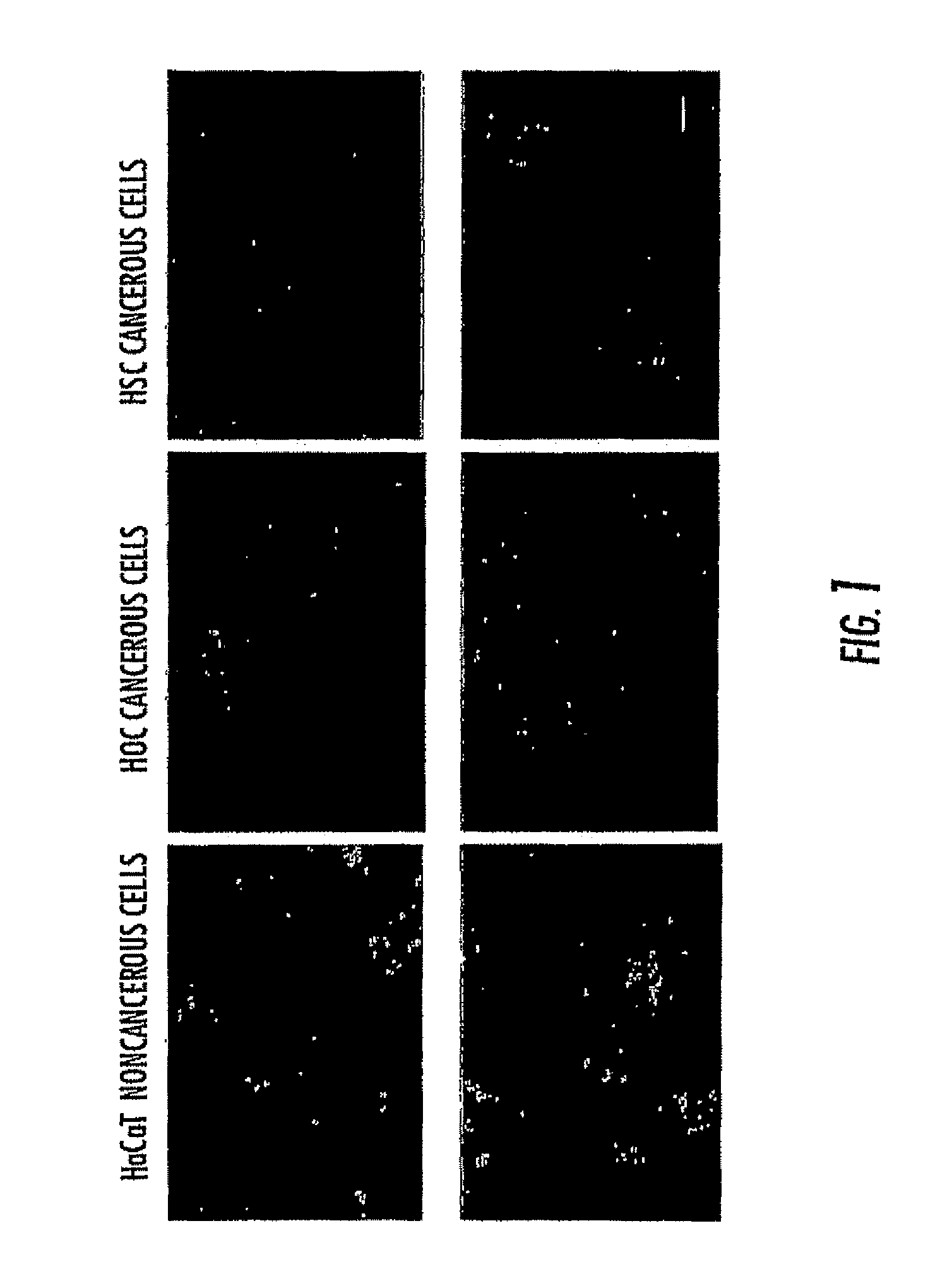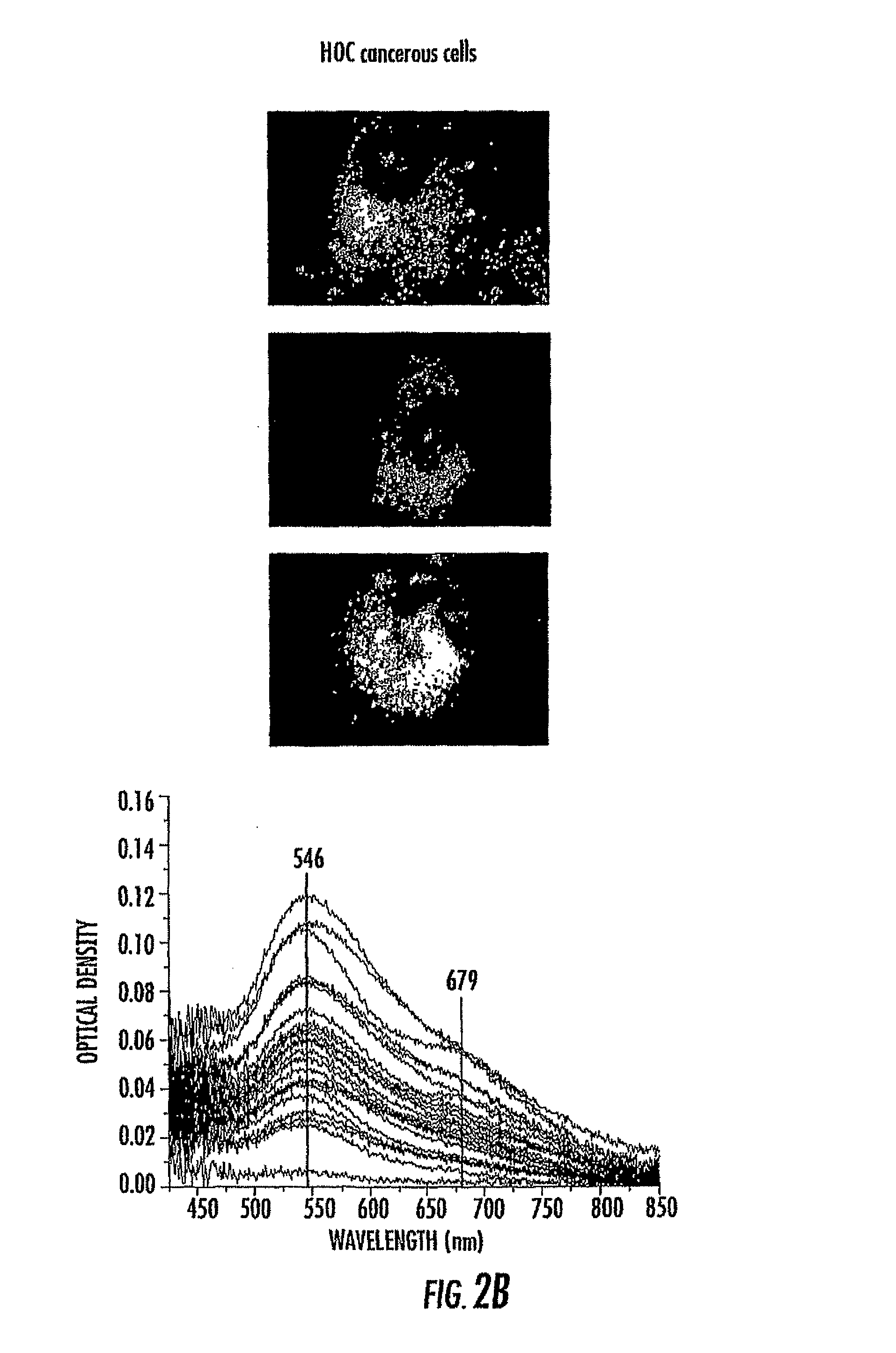Shape tunable plasmonic nanoparticles
a plasmonic nanoparticle, shape-tunable technology, applied in the direction of peptides, instruments, therapies, etc., can solve the problems of inconsistent light penetration in tumors, human toxicity and cytotoxicity of semiconductor materials, and risk of severe burns over the patient's entire body, and achieve the effect of quick conversion of light into hea
- Summary
- Abstract
- Description
- Claims
- Application Information
AI Technical Summary
Benefits of technology
Problems solved by technology
Method used
Image
Examples
example 1
Antibody Conjugated Nanospheres can be Used to Distinguish Between Malignant and Non-Malignant Cells
[0108]A very simple and inexpensive conventional microscope with proper rearrangement of the illumination system and the light collection system was used to imaging cells which were incubated with colloidal gold or with anti-epidermal growth factor receptor (anti-EGFR) antibody conjugated gold nanoparticles. The optical properties of the gold nanoparticles incubated in single living cancerous and noncancerous cells are compared for different incubation methods. It is found that the scattering images and the absorption spectra recorded from anti-EGFR antibody conjugated gold nanospheres incubated with cancerous and noncancerous cells are very different and offer potential techniques for cancer diagnostics.
[0109]One nonmalignant epithelial cell line HaCaT (human keratinocytes), and two malignant epithelial cell lines HOC 313 clone 8 and HSC 3 (human oral squamous cell carcinoma) were cu...
example 2
Light Scattering Images of Antibody Conjugated Nanospheres
[0115]The light scattering pattern of gold nanoparticles is significantly different when anti-EGFR antibodies were conjugated to gold nanoparticles before incubation with the cells (FIG. 3). The HaCaT on cancerous cells are poorly labeled by the nanoparticles and the cells could not be identified individually (FIG. 3, three images on the left column). When the conjugates are incubated with HOC FIG. 3, three images on the middle column) and HSC (FIG. 3, tree images on the right column) cancerous cells for the same amount of time, the nanoparticles are found on the surface of the cells, especially on the cytoplasm membranes for HSC cancer cells. This contrast difference is due to the specific binding of overexpressed EGFR on the cancer cells with the anti-EGFR antibodies on the gold surface. The nanoparticles are also found on the HaCaT noncancerous cells due to part of the specific binding, but mostly due to the nonspecific in...
example 3
Selectivity of Anti-EGFR Antibody Conjugated Au Nanoparticles
[0118]The strongly scattered colored light of gold nanoparticles is easily observed in a simple dark field setup. In live cell cultures, immuno-targeted nanoparticles successfully label and distinguish the malignant HOC and HSC cells from the HaCaT benign cells. The surface plasmon absorption spectrum itself can differentiate between the malignant and benign cells. FIG. 4 shows the light scattering pattern of anti-EGFR antibody conjugated gold nanoparticles on the surface of benign and malignant cells that are used in the laser irradiation experiment. The HaCaT cells (FIG. 4, left) are poorly labeled with the nanoparticles. When the Au conjugates are incubated with USC (FIG. 4, middle) and HOC (FIG. 4, right) for an equal amount of time, the cell surfaces are heavily labeled with the gold nanoparticles due to the specific binding of the anti-EGFR antibodies to the overexpressed EGFR on the surface of the carcinoma cells. T...
PUM
| Property | Measurement | Unit |
|---|---|---|
| aspect ratio | aaaaa | aaaaa |
| wavelength | aaaaa | aaaaa |
| length | aaaaa | aaaaa |
Abstract
Description
Claims
Application Information
 Login to View More
Login to View More - R&D
- Intellectual Property
- Life Sciences
- Materials
- Tech Scout
- Unparalleled Data Quality
- Higher Quality Content
- 60% Fewer Hallucinations
Browse by: Latest US Patents, China's latest patents, Technical Efficacy Thesaurus, Application Domain, Technology Topic, Popular Technical Reports.
© 2025 PatSnap. All rights reserved.Legal|Privacy policy|Modern Slavery Act Transparency Statement|Sitemap|About US| Contact US: help@patsnap.com



